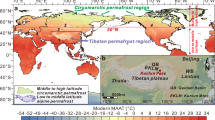Abstract
Interpretation of stable isotope profiles from polar ice cores in terms of past climate requires a knowledge of the elevation at which the ice found at any depth was formed. Measurement of the total gas content of polar ice, V, can give such information if the volume of the pores in ice is known for the time they close off from the atmosphere at the ice formation site1. For the 1,387-m long core from Camp Century in north-west Greenland, estimates, based on the assumption of a constant pore volume at close-off, suggested that, on the average, ice from the Wisconsin/Weichsel period was formed at an elevation about 1,200–1,400 m higher than that from the Holocene2. This would account for an important part of the large shift in the stable oxygen isotopic ratio in this core between late Wisconsin and Holocene ice that was observed by Dansgaard and others3. However, if the pore volume at close-off depends on the site of origin for the ice, estimates of elevation of origin by the gas content method can be seriously in error unless the effect can be allowed for quantitatively. We present here results that enable us to describe the variations in the total gas content of ice that has been formed in present-day conditions in Antarctica and Greenland for a wide range of temperature (−12 to −53 °C) and elevation (400 to 3,200 m). Using these results, the gas content method can now be applied with much greater confidence than before to indicate past elevation changes.
This is a preview of subscription content, access via your institution
Access options
Subscribe to this journal
Receive 51 print issues and online access
$199.00 per year
only $3.90 per issue
Buy this article
- Purchase on Springer Link
- Instant access to full article PDF
Prices may be subject to local taxes which are calculated during checkout
Similar content being viewed by others
References
Raynaud, D. & Lorius, C. Nature 243, 283–284 (1973).
Raynaud, D. & Lorius, C. in Isotopes and Impurities in Snow and Ice, 326–335 (IAHS Publ 118, 1977).
Dansgaard, W., Johnsen, S. J., Clausen, H. B. & Langway, C. C. Jr in Late Cenozoic Ice Ages (ed. Turekian K. K.) 37–56 (Yale University Press, 1971).
Raynaud, D. Laboratoire de Glaciologie du CNRS Publ. 214 (1977).
Lebel, B. Laboratoire de Glaciologie du CNRS Publ. 255 (1979).
Whillans, I. M. J. Glaciol. (in the press).
Budd, W. F. & Morgan, V. I. in Isotopes and Impurities in Snow and Ice, 312–321 (IAHS Publ. 118, 1977).
Miller, K. J. M.A. thesis, State Univ. New York, Buffalo (1978).
Dansgaard, W., Johnsen, S. J., Clausen, H. B. & Gundestrup, N. Meddr. Grønland 197, No. 2 (1973).
Author information
Authors and Affiliations
Rights and permissions
About this article
Cite this article
Raynaud, D., Lebel, B. Total gas content and surface elevation of polar ice sheets. Nature 281, 289–291 (1979). https://doi.org/10.1038/281289a0
Received:
Accepted:
Issue Date:
DOI: https://doi.org/10.1038/281289a0
This article is cited by
-
Eemian interglacial reconstructed from a Greenland folded ice core
Nature (2013)
-
The effective age of bubbles in polar ice
Pure and Applied Geophysics PAGEOPH (1985)
-
Age difference between polar ice and the air trapped in its bubbles
Nature (1984)
-
Polar ice sheets: Developments since Wegener
Geologische Rundschau (1981)
-
Polar ice evidence that atmospheric CO2 20,000 yr BP was 50% of present
Nature (1980)
Comments
By submitting a comment you agree to abide by our Terms and Community Guidelines. If you find something abusive or that does not comply with our terms or guidelines please flag it as inappropriate.



